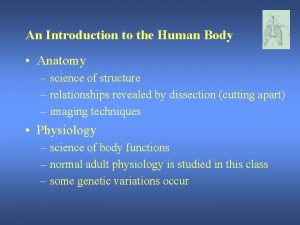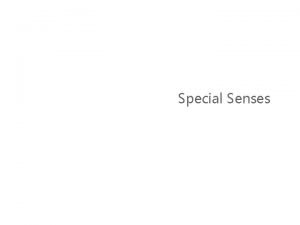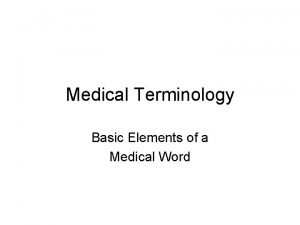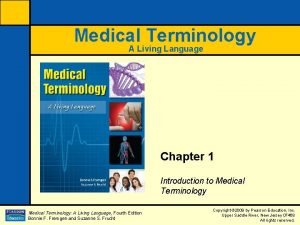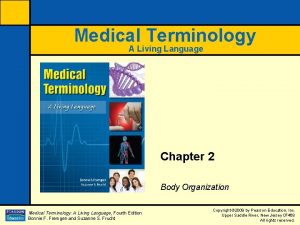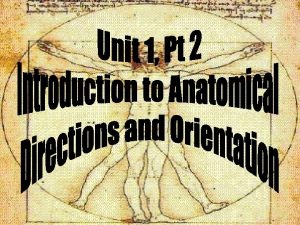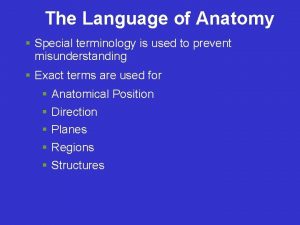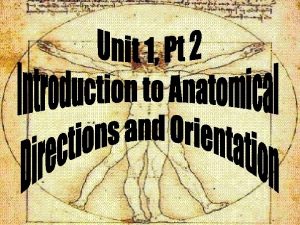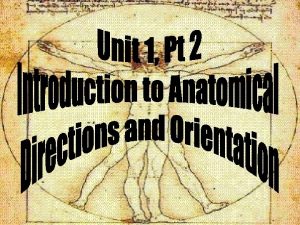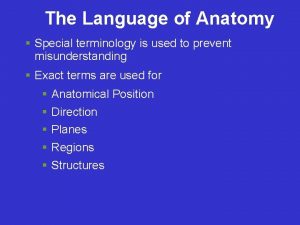The Language of Anatomy Special terminology is used















- Slides: 15

The Language of Anatomy • Special terminology is used to prevent misunderstanding • Exact terms are used for • Position • Direction • Regions • Structures © 2012 Pearson Education, Inc.

Directional Terms • Superior (cranial or cephalad): toward the head end or upper part of a structure or the body; above • Inferior (caudal): away from the head end or toward the lower part of a structure or the body; below © 2012 Pearson Education, Inc.

© 2012 Pearson Education, Inc. Table 1. 1

Directional Terms • Ventral (anterior): toward or at the front of the body; in front of • Dorsal (posterior): toward or at the backside of the body; behind © 2012 Pearson Education, Inc.

© 2012 Pearson Education, Inc. Table 1. 1

Directional Terms • Medial: toward or at the midline of the body; on the inner side of • Lateral: away from the midline of the body; on the outer side of • Intermediate: between a more medial and a more lateral structure © 2012 Pearson Education, Inc.

© 2012 Pearson Education, Inc. Table 1. 1

Directional Terms • Proximal: close to the origin of the body part or point of attachment to a limb to the body trunk • Distal: farther from the origin of a body part or the point of attachment of a limb to the body trunk © 2012 Pearson Education, Inc.

© 2012 Pearson Education, Inc. Table 1. 1

Directional Terms • Superficial: toward or at the body surface • Deep: away from the body surface; more internal © 2012 Pearson Education, Inc.

© 2012 Pearson Education, Inc. Table 1. 1

Body Planes and Sections • A sagittal section divides the body (or organ) into left and right parts. • A median, or midsagittal, section divides the body (or organ) into equal left and right parts. • A frontal, or coronal, section divides the body (or organ) into anterior and posterior parts. • A transverse, or cross, section divides the body (or organ) into superior and inferior parts. © 2012 Pearson Education, Inc.

(a) Median (midsagittal) Vertebral column Rectum © 2012 Pearson Education, Inc. Intestines (b) Frontal (coronal) plane Right lung Heart Liver Left lung Stomach Spleen (c) Transverse plane Liver Aorta Spinal cord Spleen Subcutaneous Stomach fat layer Figure 1. 6

Body Cavities • Dorsal body cavity • Cranial cavity houses the brain • Spinal cavity houses the spinal cord • Ventral body cavity • Thoracic cavity houses heart, lungs, and others • Abdominopelvic cavity houses digestive system and most urinary system organs © 2012 Pearson Education, Inc.

Cranial cavity Thoracic cavity Spinal cavity Abdominal cavity Pelvic cavity Abdominopelvic cavity Diaphragm KEY: Dorsal body cavity © 2012 Pearson Education, Inc. Ventral body cavity Figure 1. 7
 Brisbane 2000 classification
Brisbane 2000 classification Human anatomy terminology
Human anatomy terminology Basic anatomy terminology
Basic anatomy terminology Anatomy and physiology chapter 8 special senses
Anatomy and physiology chapter 8 special senses Special senses anatomy
Special senses anatomy Chapter 1 basic elements of a medical word
Chapter 1 basic elements of a medical word Special protective equipment used in firefighting except
Special protective equipment used in firefighting except Medical terminology a living language
Medical terminology a living language Medical terminology a living language 6th edition
Medical terminology a living language 6th edition Hát kết hợp bộ gõ cơ thể
Hát kết hợp bộ gõ cơ thể Frameset trong html5
Frameset trong html5 Bổ thể
Bổ thể Tỉ lệ cơ thể trẻ em
Tỉ lệ cơ thể trẻ em Gấu đi như thế nào
Gấu đi như thế nào Glasgow thang điểm
Glasgow thang điểm Chúa yêu trần thế
Chúa yêu trần thế

